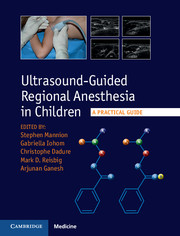Book contents
- Frontmatter
- Contents
- List of contributors
- 1 Introduction
- Section 1 Principles and practice
- Section 2 Upper limb
- Section 3 Lower limb
- Section 4 Truncal blocks
- Section 5 Neuraxial blocks
- 18 Ultrasound-guided epidural anesthesia
- 19 Ultrasound for spinal anesthesia
- 20 Ultrasound-guided caudal block
- Section 6 Facial blocks
- Appendix: Muscle innervation, origin, insertion, and action
- Index
- References
20 - Ultrasound-guided caudal block
from Section 5 - Neuraxial blocks
Published online by Cambridge University Press: 05 September 2015
- Frontmatter
- Contents
- List of contributors
- 1 Introduction
- Section 1 Principles and practice
- Section 2 Upper limb
- Section 3 Lower limb
- Section 4 Truncal blocks
- Section 5 Neuraxial blocks
- 18 Ultrasound-guided epidural anesthesia
- 19 Ultrasound for spinal anesthesia
- 20 Ultrasound-guided caudal block
- Section 6 Facial blocks
- Appendix: Muscle innervation, origin, insertion, and action
- Index
- References
Summary
Clinical use
Caudal epidural blockade is the most frequently used regional anesthesia technique in pediatric patients. Caudal block in children provides intra- and postoperative pain control in surgical procedures below the umbilicus (perineal, genitourinary, ilioinguinal, lower extremity surgery), and it is almost always performed under general anesthesia. The technique can occasionally be used as the sole anesthetic in high-risk patients (newborn and premature infants, neuromuscular disease, malignant hyperthermia susceptibility) in order to reduce the risks associated with general anesthesia. Caudal analgesia is produced by injection of local anesthetic (LA) into the caudal canal through the sacral hiatus. The success rate depends upon accurate identification of the hiatus and an adequate needle insertion angle.
The incidence of serious complications that can result in patient harm or sequelae is very low, particularly with single shot caudal blocks. The most common adverse event associated with caudal block in children is the inability to place the block or block failure followed by urinary retention (Polaner et al., 2012).
In children, the size and position of the spinal cord is different from adults: at birth the cord ends at L3/L4 and the dura mater at S3. That may increase the risk of spine injury during advancement of the caudal needle. The distance between dural sac and hiatus varies, but it is less than 10 mm in newborns. As the child grows, the cord and the dural sac rise to reach their adult level L1/L2 and S2, respectively, by the end of the first year of life. In newborns and infants, the sacral bone is composed mostly of cartilage and soft bony tissue that increases the risk of bone penetration and rectal puncture.
Ultrasonography allows for easy identification of sacral anatomy (specifically the relation of the sacral hiatus to the dural sac and the search of occult spinal dysraphism) before attempting the block. This is particularly important in children with an anatomy that is difficult to define by palpation alone. By using ultrasound, the anesthetist can visualize the cranial spread of LA in the caudal–epidural space, or the placement of an epidural catheter. Ultrasound guidance offers a reliable caudal block for pediatric patients with the advantages of easier performance and fewer complications compared with traditional sacral canal injection (Wang et al., 2013).
- Type
- Chapter
- Information
- Ultrasound-Guided Regional Anesthesia in ChildrenA Practical Guide, pp. 140 - 146Publisher: Cambridge University PressPrint publication year: 2015



